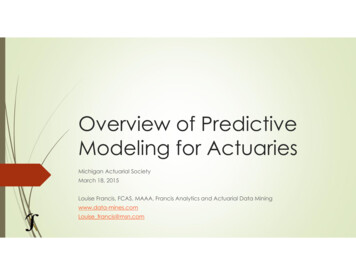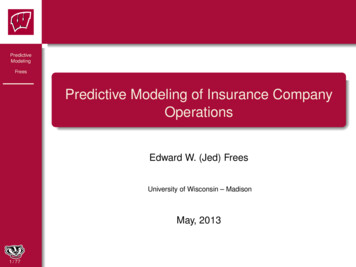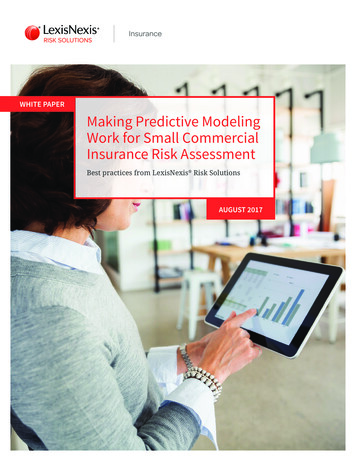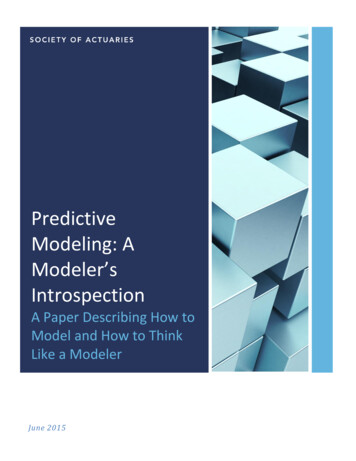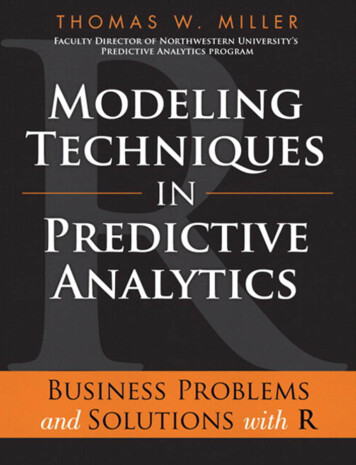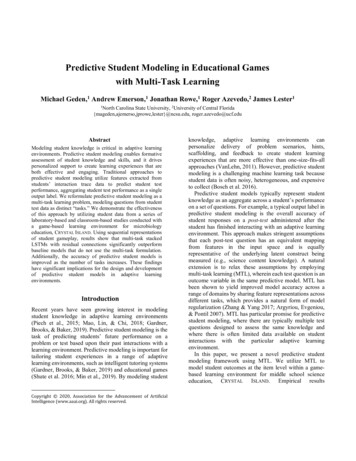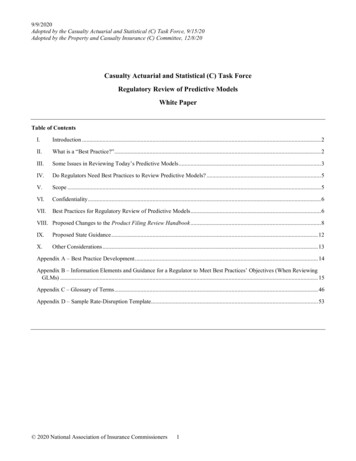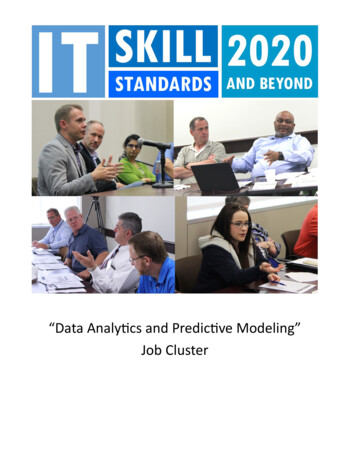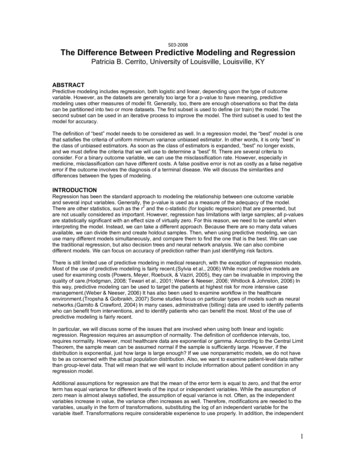
Transcription
S03-2008The Difference Between Predictive Modeling and RegressionPatricia B. Cerrito, University of Louisville, Louisville, KYABSTRACTPredictive modeling includes regression, both logistic and linear, depending upon the type of outcomevariable. However, as the datasets are generally too large for a p-value to have meaning, predictivemodeling uses other measures of model fit. Generally, too, there are enough observations so that the datacan be partitioned into two or more datasets. The first subset is used to define (or train) the model. Thesecond subset can be used in an iterative process to improve the model. The third subset is used to test themodel for accuracy.The definition of “best” model needs to be considered as well. In a regression model, the “best” model is onethat satisfies the criteria of uniform minimum variance unbiased estimator. In other words, it is only “best” inthe class of unbiased estimators. As soon as the class of estimators is expanded, “best” no longer exists,and we must define the criteria that we will use to determine a “best” fit. There are several criteria toconsider. For a binary outcome variable, we can use the misclassification rate. However, especially inmedicine, misclassification can have different costs. A false positive error is not as costly as a false negativeerror if the outcome involves the diagnosis of a terminal disease. We will discuss the similarities anddifferences between the types of modeling.INTRODUCTIONRegression has been the standard approach to modeling the relationship between one outcome variableand several input variables. Generally, the p-value is used as a measure of the adequacy of the model.There are other statistics, such as the r2 and the c-statistic (for logistic regression) that are presented, butare not usually considered as important. However, regression has limitations with large samples; all p-valuesare statistically significant with an effect size of virtually zero. For this reason, we need to be careful wheninterpreting the model. Instead, we can take a different approach. Because there are so many data valuesavailable, we can divide them and create holdout samples. Then, when using predictive modeling, we canuse many different models simultaneously, and compare them to find the one that is the best. We can usethe traditional regression, but also decision trees and neural network analysis. We can also combinedifferent models. We can focus on accuracy of prediction rather than just identifying risk factors.There is still limited use of predictive modeling in medical research, with the exception of regression models.Most of the use of predictive modeling is fairly recent.(Sylvia et al., 2006) While most predictive models areused for examining costs (Powers, Meyer, Roebuck, & Vaziri, 2005), they can be invaluable in improving thequality of care.(Hodgman, 2008; Tewari et al., 2001; Weber & Neeser, 2006; Whitlock & Johnston, 2006) Inthis way, predictive modeling can be used to target the patients at highest risk for more intensive casemanagement.(Weber & Neeser, 2006) It has also been used to examine workflow in the healthcareenvironment.(Tropsha & Golbraikh, 2007) Some studies focus on particular types of models such as neuralnetworks.(Gamito & Crawford, 2004) In many cases, administrative (billing) data are used to identify patientswho can benefit from interventions, and to identify patients who can benefit the most. Most of the use ofpredictive modeling is fairly recent.In particular, we will discuss some of the issues that are involved when using both linear and logisticregression. Regression requires an assumption of normality. The definition of confidence intervals, too,requires normality. However, most healthcare data are exponential or gamma. According to the Central LimitTheorem, the sample mean can be assumed normal if the sample is sufficiently large. However, if thedistribution is exponential, just how large is large enough? If we use nonparametric models, we do not haveto be as concerned with the actual population distribution. Also, we want to examine patient-level data ratherthan group-level data. That will mean that we will want to include information about patient condition in anyregression model.Additional assumptions for regression are that the mean of the error term is equal to zero, and that the errorterm has equal variance for different levels of the input or independent variables. While the assumption ofzero mean is almost always satisfied, the assumption of equal variance is not. Often, as the independentvariables increase in value, the variance often increases as well. Therefore, modifications are needed to thevariables, usually in the form of transformations, substituting the log of an independent variable for thevariable itself. Transformations require considerable experience to use properly. In addition, the independent1
variables are assumed to be independent of each other. While the model can tolerate some correlationbetween these variables, too much correlation will result in a poor model that cannot be used effectively onfresh data. A similar problem occurs if the independent variables have different range scales. If most of thevariables are 0-1 indicator functions with patient’s age as a scale of 0-100, the value of age will completelydominate the regression equation. The variable scales should be standardized before the model isdeveloped.Probably the most worrisome is the assumption that the error terms are identically distributed. In order forthis assumption to be valid, we must assume the uniformity of data entry. That means that all providers mustenter poorly defined values in exactly the same way. Unfortunately, such an assumption cannot possibly bevalid. Consider, for example, the condition of “uncontrolled diabetes,” which is one coded patient condition.The term, “uncontrolled” is not defined. Therefore, the designation remains at the discretion of the providerto define the term. For this reason, different providers will define it differently.LOGISTIC REGRESSIONWe want to see if we can predict mortality in patients using a logistic regression model. There isconsiderable incentive to increase the number of positive indicators, called upcoding. The value,α X α X . α X12222525increases as the number of nonzero X’s increases. The greater this value, the greater the likelihood that itwill cross the threshold value that predicts mortality.However, consider for a moment that just about every patient condition has a small risk of mortality. Oncethe threshold value is crossed, every patient with similar conditions are predicted to die. Therefore, the morepatients who can be defined over the threshold value, the higher the predicted mortality rate, decreasing thedifference between predicted and actual mortality. There is considerable incentive to upcode patientdiagnoses to increase the likelihood of crossing this threshold vlaue.To simplify, we start with just one input variable to the logistic regression; the occurrence of pneumonia.Table 1 gives the chi-square table for the two variables.Table 1. Chi-square Table for Mortality by PneumoniaTable of pneumonia by DIEDpneumoniaTotalDIEDFrequencyRow PctCol 7TotalFrequency Missing 3041Approximately 7% of the patients with pneumonia died compared to just under 2% generally. However, if weconsider the classification table (Table 2) for a logistic regression with pneumonia as the input and mortalityas the outcome variable, the accuracy rate is above 90% for any choice of threshold value of less than 1.0,where 100% of the values are to predict non-mortality. Therefore, even though patients with pneumonia arealmost 4 times as likely to die compared to patients without pneumonia, pneumonia by itself is a poorpredictor of mortality because of the rare occurrence.2
Table 2. Classification Table for Logistic RegressionClassification 100.0.97.9We now add a second patient diagnosis to the regression. Table 3 gives the chi-square table for pneumoniaand septicemia.Table 3. Chi-square Table for Pneumonia and SepticemiaControlling for septicemia 0pneumoniaDiedFrequencyRow PctCol 4.807676279TotalControlling for septicemia 28.3223.9135123125542780182114857841608190186Of the patients with septicemia only (pneumonia 0), 20% died, increasing to 28% with both septicemia andpneumonia. For patients without septicemia but with pneumonia, 5% died. The classification table for thelogistic regression is given in Table 4.Table 4. Classification Table for Logistic Regression With Pneumonia and SepticemiaClassification 9948157E32517597.799.76.02.071.73
Classification .9Again, for any threshold value below 98%, the logistic regression model will be over 90% accurate byidentifying most of the observations as non-occurrences so that the false negative rate is over 70%. In otherwords, adding a second input variable did not change the problems with the regression, which are causedby attempting to predict a rare occurrence. We add Immune Disorder to the model (Table 5).Table 5. Classification Table Adding Immune DisorderClassification 2.070.34
Classification 00.0.97.9The problem still persists, and will continue to persist regardless of the number of input variables. We needto change the sample size so that the group sizes are close to equal.PREDICTIVE MODELING IN SAS ENTERPRISE MINERFigure 1 gives a diagram of a predictive model in SAS Enterprise Miner. Enterprise Miner includes thestandard types of regression, artificial neural networks, and decision trees. The regression model will chooselinear or logistic automatically, depending upon the type of outcome variable. Figure 1 shows that manydifferent models can be used. Once defined, the models are compared and the optimal model chosen basedupon pre-selected criteria. Then, additional data can be scored so that patients, in this example, at high riskfor adverse events can be identified for more aggressive treatment.The purpose of the partition node in Figure 1 is to divide the data into training, validation, and testingsubsets, by default, a 40/30/30 split in the data. Usually, the datasets are large enough that such apartitioning is possible. The training set is used to define the model; the testing set is a holdout sample usedas fresh data to test the accuracy of the model. The validation set is not needed for regression; it is neededfor neural networks and any model that is defined iteratively. The model is examined on the validation set,and adjustments are made to the model if necessary. This process is repeated until no more changes arenecessary.5
Figure 1. Predictive Modeling of Patient OutcomesFor predicting a rare occurrence, one more node is added to the model in Figure 1, the sampling node(Figure 2). This node uses all of the observations with the rare occurrence, and then takes a random sampleof the remaining data. While the sampling node can use any proportional split, we recommend a 50:50 split.Figure 3 shows how the defaults are modified in the sampling node of SAS Enterprise Miner to makepredictions.6
Figure 2. Addition of Sampling Node7
Figure 3. Change to Defaults in Sampling NodeThe first arrow indicates that the sampling is stratified, and the criterion is level based. The rarest level (inthis case, mortality) is sampled so that it will consist of half (50% sample proportion) of the sample.Consider the problem of predicting mortality that was discussed in the previous section on logisticregression. We use just the same three patient diagnoses of pneumonia, septicemia, and immune disorderthat we used previously. However, in this case, we use the sampling node to get a 50/50 split in the data.We use all of the models depicted in Figure 1. According to the model comparison, the rule inductionprovides the best fit, using the misclassification rate as the measure of “best”. We first look at the regressionmodel, comparing the results to those in the previous chapter when a 50/50 split was not performed. Theoverall misclassification rate is 28%, with the divisions as shown in Table 6.Table 6. Misclassification in Regression ModelTargetOutcome Target PercentageTraining Data0067.81032.20123.81176.3Validation Data0067.71032.30123.81176.2Outcome PercentageCountTotal 19.29.630.78
Note that the misclassification becomes more balanced between false positives and false negatives with a50/50 split in the data. The model gives heavier weight to false positives than it does to false negatives.We also want to examine the decision tree model. While it is not the most accurate model, it is one thatclearly describes the rationale behind the predictions. This tree is given in Figure 4. The tree shows that thefirst split occurs on the variable, Septicemia. Patients with Septicemia are more likely to suffer mortalitycompared to patients without Septicemia. As shown in the previous chapter, the Immune Disorder has thenext highest level of mortality followed by Pneumonia.Figure 4. Decision Tree ResultsSince rule induction is identified as the best model, we examine that one next. The misclassification rate isonly slightly smaller compared to the regression model. Table 7 gives the classification table.Table 7. Misclassification in Rule Induction ModelTargetOutcome Target PercentageTraining Data0067.81032.20123.81176.3Validation DataOutcome PercentageCountTotal 19.29.630.89
TargetTraining Data0101OutcomeTarget PercentageOutcome PercentageCountTotal 81931596463083040.419.29.630.7The results look virtually identical to those in Table 6. For this reason, the regression model, although notdefined as the best, can be used to predict outcomes when only these three variables are used. Thesimilarities in the models can also be visualized in the ROC (received-operating curve) that graphs thesensitivity versus one minus the specificity (Figure 5). The curves for rule induction and regression arevirtually the same.Figure 5. Comparison of ROC CurvesMANY VARIABLES IN LARGE SAMPLESThere can be hundreds if not thousands of variables collected for each patient. These are far too many toinclude in any predictive model. The use of too many variables can cause the model to over-fit the results,inflating the outcomes. Therefore, there needs to be some type of variable reduction method. In the past,factor analysis has been used to reduce the set of variables prior to modeling the data. However, there isnow a more novel method available (Figure 6).In our example, there are many additional variables that can be considered in this analysis. Therefore, weuse the variable selection technique to choose the most relevant. We first use the decision tree followed byregression, and then regression followed by the decision tree.10
Figure 6. Variable SelectionUsing the decision tree to define the variables, Figure 7 shows the ones that remain for the modeling.Figure 7. Decision Tree VariablesThis tree shows that age, length of stay, having septicemia, immune disorder, and total charges are relatedto mortality. The remaining variables have been rejected from the model. The rule induction is the bestmodel, and the misclassification rate decreases to 22% with the added variables. The ROC curve looksconsiderably improved (Figure 8).11
Figure 8. ROC Curves for Models Following Decision TreeThe ROC curve is much higher compared to that in Figure 5. If we use regression to perform the variableselection, the results remain the same. In addition, a decision tree is virtually the same when it follows theregression compared to when it precedes (Figure 9).Figure 9. Decision Tree Following RegressionThe above example only used three possible diagnosis codes. We want to expand upon the number ofdiagnosis codes, and also to use a number of procedure codes. In this example, we restrict our attention to12
patients with a primary diagnosis of COPD (chronic obstructive pulmonary disease resulting primarily fromsmoking). There are approximately 245,000 patients in the NIS dataset. Table 8 gives the list of diagnosiscodes used; Table 9 gives a list of procedure codes used as well.Table 8. Diagnosis Codes Used to Predict MortalityConditionICD9 CodesAcute myocardial 410, 412infarctionCongestive heart 428failurePeripheral441,4439,7854,V434vascular ,7142,7148,5171,725tissue disorderPeptic ulcer531,532,533,534Liver gia342,3441Renal 75,176,179,190,191,193, ,203, cancerSevere liver5722,5723,5724,5728diseaseHIV042,043,044Table 9. Procedure Codes Used to Predict Mortality13
prProcedure TranslationFrequencyPercent9904Transfusion of packed cells177567.053893Venous catheterization, not elsewhere classified161426.419671Continuous mechanical ventilation for less than 96 consecutive hours105284.183324Closed [endoscopic] biopsy of bronchus83153.309672Continuous mechanical ventilation for 96 consecutive hours or sis80833.219604Insertion of endotracheal tube75793.019921Injection of antibiotic67862.699394Respiratory medication administered by nebulizer63092.508872Diagnostic ultrasound of heart54192.154516Esophagogastroduodenoscopy [EGD] with closed biopsy48941.949390Continuous positive airway pressure46671.853327Closed endoscopic biopsy of lung34461.378741Computerized axial tomography of thorax34171.364513Other endoscopy of small intestine32771.30If we perform standard logistic regression without stratified sampling, the false positive rate remains small(approximately 3-4%), but with a high false negative rate (minimized at 38%). Given the large dataset,almost all of the input variables are statistically significant. The percent agreement is 84% and the ROCcurve looks fairly good (Figure 10).Figure 10. ROC Curve for Traditional Logistic Regression14
If we perform predictive modeling, the accuracy rate drops to 75%, but the false negative rate isconsiderably improved. Figure 11 gives the ROC curve from predictive modeling.Figure 11. ROC From Predictive ModelingCHANGE IN SPLIT IN THE DATAAll of the analyses in the previous section assumed a 50/50 split between mortality and non-mortality. Wewant to look at the results if mortality composes only 25% of the data, and 10% of the data. Table 10 givesthe regression classification breakdown for a 25% sample; Table 11 gives the breakdown for a 10% sample.Table 10. Misclassification Rate for a 25% SampleTargetOutcome Target PercentageTraining Data0080.41019.60125.61174.4Validation Data0080.21019.80123.71176.2Outcome PercentageCountTotal te that the ability to classify mortality accurately is decreasing with the decrease of the split; almost all ofthe observations are classified as non-mortality. The decision tree (Figure 12) is considerably different fromthat in Figure 9 with a 50/50 split. Now, the procedure of Esophagogastroduodenoscopy gives the first leafof the tree.Figure 12. Decision Tree for 25/75 Split in the Data15
Table 11. Misclassification Rate for a 10% SampleTargetOutcome Target PercentageTraining Data0091.5108.50127.31172.6Validation Data0091.5108.40127.81172.2Outcome PercentageCountTotal 1.699.282.40.717.523265214817645789.38.20.71.7Note that the trend shown in the 25% is even more exaggerated in the 10% sample. Figure 13 shows thatthe decision tree has changed yet again. It now includes the procedure of continuous positive airwaypressure and the diagnosis of congestive heart failure. AT a 1% sample, the misclassification becomeseven more disparate.Figure 13. Decision Tree for 10% Sample16
ADDITION OF WEIGHTS FOR DECISION MAKINGIn most medical studies, a false negative is more costly to the patient compared to a false positive. Thisoccurs because a false positive generally leads to more invasive tests; however, a false negative means thata potentially life-threatening illness will go undiagnosed, and hence, untreated. Therefore, we can weight afalse negative at higher cost, and then change the definition of a “best” model to one that minimizes costs.The problem is to determine which costs to use.The best thing to do is to experiment with magnitudes of difference in cost between the false positive andfalse negative to see what happens. At a 1:1 ratio, the best model is still based upon the misclassificationrate. A change to a 5:1 ratio indicates that a false negative is five times as costly compared to a falsepositive. A 10:1 ratio makes it ten times as costly. We need to determine if changes to this ratio result inchanges to the optimal model.INTRODUCTION TO LIFTLift allows us to find the patients at highest risk for occurrence, and with the greatest probability of accurateprediction. This is especially important since these are the patients we would want to take the greatest carefor.Using lift, true positive patients with highest confidence come first, followed by positive patients with lowerconfidence. True negative cases with lowest confidence come next, followed by negative cases with highestconfidence. Based on that ordering, the observations are partitioned into deciles, and the following statisticsare calculated:17
The Target density of a decile is the number of actually positive instances in that decile divided bythe total number of instances in the decile.The Cumulative target density is the target density computed over the first n deciles.The lift for a given decile is the ratio of the target density for the decile to the target density over allthe test data.The Cumulative lift for a given decile is the ratio of the cumulative target density to the targetdensity over all the test data.Given a lift function, we can decide on a decile cutpoint so that we can predict the high risk patients abovethe cutpoint, and predict the low risk patients below a second cutpoint, while failing to make a definiteprediction for those in the center. In that way, we can dismiss those who have no risk, and aggressively treatthose at highest risk. Lift allows us to distinguish between patients without assuming a uniformity of risk.Figure 14 shows the lift for the testing set when we use just the three input variables of pneumonia,septicemia, and immune disorder.Figure 14. Lift Function for Three-Variable InputRandom chance is indicates by the lift value of 1.0; values that are higher than 1.0 indicate that theobservations are more predictable compared to random chance. In this example, 40% of the patient recordshave a higher level of prediction than just chance. Therefore, we can concentrate on these 4 deciles ofpatients. If we use the expanded model that includes patient demographic information plus additionaldiagnosis and procedure codes for COPD, we get the lift shown in Figure 15. The model can now predict thefirst 5 deciles of patient outcomes.Figure 15. Lift Function for Complete ModelTherefore, we can predict accurately those patients most at risk for death; we can determine which patientscan benefit from more aggressive treatment to reduce the likelihood that this outcome will occur.DISCUSSIONGiven large datasets and the presence of outliers, the traditional statistical methods are not alwaysapplicable or meaningful. Assumptions can be crucial to the applicability of the model, and assumptions are18
not always carefully considered. The assumptions of a normal distribution and uniformity of data entry arecrucial and need to be considered carefully.The data may not give high levels of correlation, and regression may not always be the best way to measureassociations. It must also be remembered that associations in the data as identified in regression models donot demonstrate cause and effect.CONTACT INFORMATIONPatricia CerritoDepartment of MathematicsUniversity of LouisvilleLouisville, KY 40292502-852-6010502-852-7132 /dataservicesonlineSAS and all other SAS Institute Inc. product or service names are registered trademarks or trademarks of SAS InstituteInc. in the USA and other countries. indicates USA registration.Other brand and product names are trademarks of their respective companies.19
Predictive modeling includes regression, both logistic and linear, depending upon the type of outcome variable. However, as the datasets are generally too large for a p-value to have meaning, predictive modeling uses other measures of model fit. Gener

